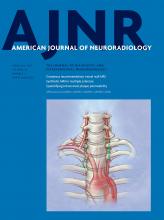Research ArticleINTERVENTIONAL
Testing Stenting and Flow Diversion Using a Surgical Elastase-Induced Complex Fusiform Aneurysm Model
R. Fahed, T.E. Darsaut, I. Salazkin, J.-C. Gentric, M. Mazighi and J. Raymond
American Journal of Neuroradiology February 2017, 38 (2) 317-322; DOI: https://doi.org/10.3174/ajnr.A5018
R. Fahed
aFrom the Centre Hospitalier de l'Université de Montréal (R.F., I.S., J.R.), Interventional Neuroradiology Research Laboratory, Notre-Dame Hospital, Montreal, Quebec, Canada
T.E. Darsaut
bDepartment of Surgery (T.E.D.), Division of Neurosurgery, University of Alberta Hospital, Mackenzie Health Sciences Centre, Edmonton, Alberta, Canada
I. Salazkin
aFrom the Centre Hospitalier de l'Université de Montréal (R.F., I.S., J.R.), Interventional Neuroradiology Research Laboratory, Notre-Dame Hospital, Montreal, Quebec, Canada
J.-C. Gentric
cDepartment of Radiology (J.-C.G.), Division of Neuroradiology, Centre Hospitalo-Universitaire Cavale Blanche, Brest, France
M. Mazighi
dDepartment of Interventional Neuroradiology (M.M.), Fondation Ophtalmologique Adolphe de Rothschild, Paris, France.
J. Raymond
aFrom the Centre Hospitalier de l'Université de Montréal (R.F., I.S., J.R.), Interventional Neuroradiology Research Laboratory, Notre-Dame Hospital, Montreal, Quebec, Canada

References
- 1.↵
- Brinjikji W,
- Murad MH,
- Lanzino G, et al
- 2.↵
- Darsaut TE,
- Bing F,
- Salazkin I, et al
- 3.↵
- Bouzeghrane F,
- Naggara O,
- Kallmes DF, et al
- 4.↵
- Naggara O,
- Darsaut TE,
- Salazkin I, et al
- 5.↵
- Fahed R,
- Gentric JC,
- Salazkin I, et al
- 6.↵
- 7.↵
- Cloft HJ,
- Altes TA,
- Marx WF, et al
- 8.↵
- Brinjikji W,
- Ding YH,
- Kallmes DF, et al
- 9.↵
- Altes TA,
- Cloft HJ,
- Short JG, et al
- 10.↵
- Lewis DA,
- Ding YH,
- Dai D, et al
- 11.↵
- Krings T,
- Hans FJ,
- Möller-Hartmann W, et al
- 12.↵
- Hans FJ,
- Krings T,
- Möller-Hartmann W, et al
- 13.↵
- Kallmes DF,
- Helm GA,
- Hudson SB, et al
- 14.↵
- Ding YH,
- Dai D,
- Lewis DA, et al
- 15.↵
- Kallmes DF,
- Ding YH,
- Dai D, et al
- 16.↵
- Kallmes DF,
- Ding YH,
- Dai D, et al
- 17.↵
- Kilkenny C,
- Browne W,
- Cuthill IC, et al
- 18.↵
- Kamran M,
- Yarnold J,
- Grunwald IQ, et al
- 19.↵
- Sadasivan C,
- Cesar L,
- Seong J, et al
- 20.↵
- Ding YH,
- Dai D,
- Danielson MA, et al
- 21.↵
- Hoh BL,
- Rabinov JD,
- Pryor JC, et al
- 22.↵
- Wang K,
- Huang Q,
- Hong B, et al
- 23.↵
- 24.↵
- Alaqeel A,
- Meek C,
- Wong J, et al
- 25.↵
- 26.↵
- Ding YH,
- Tieu T,
- Kallmes DF
- 27.↵
- Sherif C,
- Marbacher S,
- Erhardt S, et al
- 28.↵
- Sherif C,
- Herbich E,
- Plasenzotti R, et al
- 29.↵
- 30.↵
- Darsaut TE,
- Bing F,
- Salazkin I, et al
- 31.↵
- Darsaut TE,
- Bing F,
- Salazkin I, et al
- 32.↵
- 33.↵
- Gentric JC,
- Darsaut TE,
- Makoyeva A, et al
- 34.↵
- Ding Y,
- Dai D,
- Kadirvel R, et al
In this issue
American Journal of Neuroradiology
Vol. 38, Issue 2
1 Feb 2017
Advertisement
R. Fahed, T.E. Darsaut, I. Salazkin, J.-C. Gentric, M. Mazighi, J. Raymond
Testing Stenting and Flow Diversion Using a Surgical Elastase-Induced Complex Fusiform Aneurysm Model
American Journal of Neuroradiology Feb 2017, 38 (2) 317-322; DOI: 10.3174/ajnr.A5018
0 Responses
Jump to section
Related Articles
Cited By...
- Evaluation of a novel flow diverter, the DiVeRt system, in an animal model
- Promoting endothelialization of flow-diverting stents: a review
- Transient in-stent stenosis at mid-term angiographic follow-up in patients treated with SILK flow diverter stents: incidence, clinical significance and long-term follow-up
This article has been cited by the following articles in journals that are participating in Crossref Cited-by Linking.
- Albert Busch, Ekaterina Chernogubova, Hong Jin, Felix Meurer, Hans-Henning Eckstein, Mia Kim, Lars MaegdefesselEuropean Journal of Vascular and Endovascular Surgery 2018 56 1
- Fahad Essbaiheen, Hanan AlQahtani, Taleb Mohamed Almansoori, Elena Adela Cora, Satya Patro, Vered Tsehmaister-Abitbul, Brian Drake, Howard Lesiuk, Stephanos Nikolaos Finitsis, Daniela IancuJournal of NeuroInterventional Surgery 2019 11 2
- Serge Marbacher, Fabio Strange, Juhana Frösén, Javier FandinoJournal of Cerebral Blood Flow & Metabolism 2020 40 5
- Kapilan Panchendrabose, Sandeep Muram, Alim P MithaJournal of NeuroInterventional Surgery 2021 13 1
- Haishuang Tang, Zhiwen Lu, Gaici Xue, Sisi Li, Fengfeng Xu, Yazhou Yan, Jianmin Liu, Qiao Zuo, Yin Luo, Qinghai HuangNeuroradiology 2020 62 10
- Michael B. Avery, Ahmed Alaqeel, Amy B. Bromley, Yong-Xiang Chen, John H. Wong, Muneer Eesa, Alim P. MithaJournal of Neurosurgery 2019 131 1
- Clemens Hufnagl, Erasmia Broussalis, Christophe Cognard, Jochen Grimm, Constantin Hecker, Andreas Oellerer, Muhammed Abdallah, Christoph J Griessenauer, Monika Killer-OberpfalzerJournal of NeuroInterventional Surgery 2022 14 4
More in this TOC Section
Similar Articles
Advertisement











